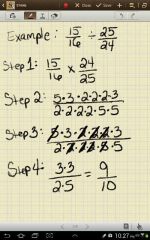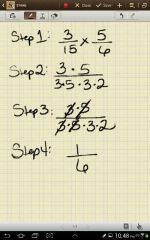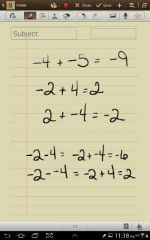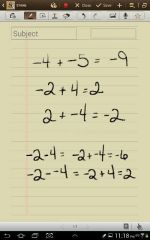![]()
![]()
![]()
Use LEFT and RIGHT arrow keys to navigate between flashcards;
Use UP and DOWN arrow keys to flip the card;
H to show hint;
A reads text to speech;
19 Cards in this Set
- Front
- Back
- 3rd side (hint)
|
Prime number defined |
A positive whole number only divisible by l and itself Example- 7.13, 19 l is NEVER a prime number |
2, 3, 5, 7, 11, 13, 17, 19, 23, 29, 31, 3? 41, 43, 47, |
|
|
Counting Numbers |
Positive Natural Numbers |
|
|
|
Composite Number |
A Counting number With more than 2 different factors |
|
|
|
Sieve of Eratosthenes |
process of eliminating multiples to find prime #'s |
|
|
|
What is the only positive Prime #? |
2 |
|
|
|
Prime Numbers less than 50 |
2, 3, 5, 7, 11, 13, 17, 19, 23, 29, 31, 37, 41, 43, 47 |
|
|
|
How do you find "multiples" of a number? |
You multiply the given number by the Counting numbers |
Example: 50 xl, 5Ox2, 5Ox3, 50 ×4 etc... |
|
|
Composite or Prime? The Sum of the numbers digits is a multiple of 3 |
Composite Example: 672 = 6+7+2 is 15 So, Since 15 is a multiple of 3 (3, 6, 9, 12, 15... ) "672" is a Composite # |
|
|
|
Are Zero and one Prime numbers? |
No, They are NOT considered prime #'s |
|
|
|
Prime Factorization |
Finding which prime numbers multiply together to make the original number. 12 / \ 6 x 2 / \ 3 x2 x 2 |
|
|
|
The Rule of Fundamental Theorem of Arithmetic |
Every Composite number has ONLY one prime factorization set 4 /\ 2×2 So the ONLY prime factorisation of the number 4 = 2×2 |
|
|
|
what are the steps to find the prime factorization of a composite number? |
l. Factor the Composite # into any 2 factors 2. Factor out each number that is a Composite to make it Prime 3. Continue this process until all factors are prime |
|
|
|
How do you find the Least Common Multiple (LCM)? |
1. Prime Factorization 1. Prime Factorization2. Write down the factors 1. Prime Factorization2. Write down the factors 2. Write down the factors |
|
|
|
How do you find the Greatest Common Factor? |
1. Find Prime Factoriazation 2. Find all factors that they share or are alike 3. Multiply those factors together |
|
|
|
Dividing Fractions |
1. Flip 2nd fraction to find the reciprical 2. make it a Multiplication problem 3. Do prime factorization of both numerators Then do prime factorization of both denominators 4. Cross out all "like" prime factors 5. Multiply straight across |

Example: |
|
|
Multiplying Fractions |
1. Do Prime Factorization on numerators 2. Do Prime Factorizations on denominator 3. Cross out any "like" factors 4. Multiply Straight across |

|
|
|
( + ) and ( - ) Multiplication Rule |
Negative x Negative = Positive Negative x Positive = Negative Positive x Positive = Positive |
|
|
|
Adding (-) and (+) |
(-) + (+) = OR (+) + (-) = subtract and use the sign of the bigger number
(-) + (-) = Add the numbers and make the answer negative |

|
|
|
Subtracting (-) and (+) |
1. Change the subtraction sign to an addition sign 2. Change the sign of the second number 3. Follow addition rules Addition rules: (-) + (-) = negative (+) + (-) = subtract and use sign of bigger number (-) + (+) = subtract and use sign of bigger number |

|

